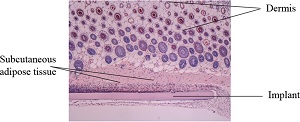 |
| Nanodiamond and silk implant delivers drugs under the skin--Courtesy of The Optical Society |
Nanodiamonds have been used in drug delivery for several years, most notably to delivery chemotherapy with fewer side effects. Now a team of U.S. and Australian researchers has added a component to the tiny vehicles that could improve their delivery properties: They've covered them in silk.
Researchers from the University of Melbourne, the University of Sydney and Tufts University in Medford, MA, say they have incorporated silk in the nanodiamond delivery process for the first time, allowing the drug carriers to play a part in imaging with the addition of fluorescence. Normally, adding fluorescence to nanodiamonds makes their edges too rough to be administered to cells; the scientists overcame this by coating the particles with transparent silk particles.
Ultimately, the researchers hope to use the nanodiamond-silk combination to deliver drugs in a way that allows them to also keep an eye on what's going on in the cell. And because silk can be designed to degrade at different rates, this could allow for a detailed release mechanism.
According to the study, published in The Optical Society's journal Biomedical Optics Express, silk provides a "transparent, robust matrix" for nanodiamonds. This matrix is needed because like any diamond, when the particles are infused with fluorescence, imperfections beyond a pure carbon base will sully the surface. In the case of the nanodiamonds, this significantly impairs their ability to exit cells through the cell membrane, making them more harmful than normal.
Prior to silk, researchers have shined these rough surfaces with lipids, but it turns out silk is more transparent and flexible, and it's also compatible with biological tissue and biodegradable, according to a report from The Optical Society. The transparency, in particular, leaves the imaging component intact and even helps it glow two to four times brighter.
In the study, the particles did not harm living tissue when implanted for two weeks.
"This nanodiamond-silk hybrid material is important due to the potential it offers to the fields of bioimaging, biosensing and drug delivery," lead author Asma Khalid said in a statement.
- here's The Optical Society's report
- and here's the abstract